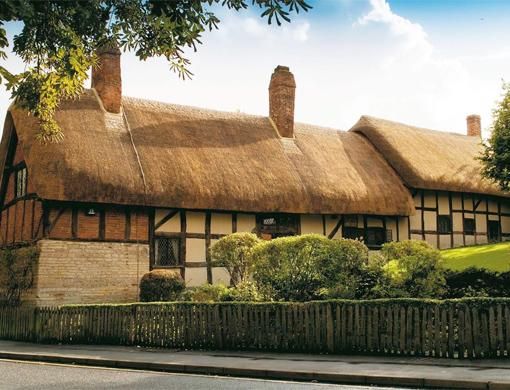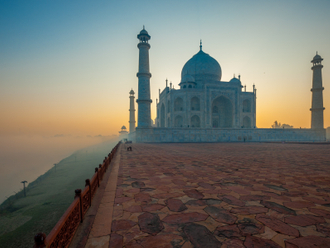For lovers of the English language, Stratford-upon-Avon needs no introduction. Birthplace of the bard, it offers plenty of images that hark back to the past. Andrea Bailey was there recently to pay homage to the world's most famous playwright.
As two rather handsome men charged towards me dressed in Elizabethan costumes, brandishing swords and spitting curses upon the Capulets, my blood ran cold. After what seemed like the longest minute (but was in fact only ten seconds), I realised that these two intimidating men must be actors playing the part of the Montague brood from Romeo and Juliet. I would never have expected that Shakespeare's work would come alive in such a dramatic manner! But here I was, in the town of his birth on that cool spring morning in Stratford-upon-Avon.
The bard's birthplace
The bus ride through the picturesque Cotswolds near Warwickshire heading towards Stratford-upon-Avon was pleasant. Tranquil green meadows lay on either side of the road. Thatched cottages stood in clusters forming tiny villages. Home to the much-loved Royal Shakespeare Company that has showcased Shakespeare's work since Victorian times, Stratford-upon-Avon is primarily known as the birthplace of the beloved bard. Born on April 23, 1564, Shakespeare spent his early years in Stratford and his house stands to this day in the centre of the quaint town.
The houses are typical of the 16th century. Shakespeare's home has been lovingly restored by the Shakespeare Birthplace Trust and made to look just as it did at the time he was a boy.
In the well-kept gardens, actors greet visitors with dramatisations from Shakespeare's plays. They run amok in the garden, waving props and hamming lines from the plays in the most thrilling fashion. Guides, who are available in each room of the house, relate the routine, sights, sounds and even the smells of a typical day in the Shakespeare household.
On the ground level of the house is the main parlour and workshop of Shakespeare's father, who was an expert glove maker and wool trader.
A flight of creaky wooden stairs takes you to the upper level that houses the bedrooms. What grabbed my attention were the colourful walls and doorposts, decorated in vivid hand-dyed designs, which are typical of the Tudor period. The original window glass is preserved to this day with the etched names of famous visitors such as Charles Dickens and John Keats who paid homage to the bard.
A little shop dedicated to selling Shakespeare memorabilia stands opposite his home, sharing the same pretty garden. I picked up what appeared to be an interesting book going by the title Shakespearean Insults. It was filled with plucky offensives such as 'Thou jarring toad-spotted babbling gossip!' and 'Thou clouted deformed odiferous stench!' Thinking the better of it, I put down the book in favour of an unoffensive mug.
After reaching the zenith of his career, he gave it all up in 1613 to return to the peace and quiet of his hometown. Stratford-upon-Avon welcomed back their most celebrated son, now a wealthy man. On April 23, 1616, he passed away at age 52 and was laid to rest at Holy Trinity Church in Stratford-upon-Avon. Fearful of gravediggers, Shakespeare penned his own epitaph a curse etched in stone, aimed at anyone who dared touch his remains.
Tales about town
Stratford was an important market town. It flanks the river Avon, hence it's rather long-winded name. Traders were the main reason for its bustling atmosphere then; it now has a heavy tourist footfall that accounts for the town's lively buzz. Charming little tea shops with boldly printed boards brightening the street offer high tea and scones with cream and jam, which are too delicious to resist. Cosy boutiques selling clothing, chocolates and jewellery are scattered amidst the supermarkets, a post office, a library and several money exchanges.
The main streets around town in those days were Wood or Bridge Street, Henley Street (where Shakespeare was born) and the main shopping hub in the High Street. Bed and breakfast signs are abundant as are small hotels along the main streets that do good business during the peak summer months.
What quickly became clear as soon as I took leave of the home of Shakespeare, was the absence of structures taller than two storeys. All the streets in Stratford-upon-Avon lead to the centrally located branch of a bank that stands at one end of Henley Street. At the other end of the Street is the Jester statue, with quotes from Shakespeare's plays on the sides of the pedestal. Walking through this absolutely delightful little town is all about discovering little nuggets of the bard's life. Contemporary boutiques and shops make up the rest of the main streets and are all teaming with tourists.
That morning, swans and boats glided down the Avon River peacefully, lending a sense of calm to the surroundings. The much-admired landmarks of the Royal Shakespeare Theatre, Gower Memorial and Bancroft Gardens are hard to miss in their architectural splendour. Holding Stratford-upon-Avon forever captive in their sculpted gaze are statues of Lady Macbeth, Hamlet, Falstaff and Prince Hal, all characters from Shakespeare's plays. These statues were strategically placed at each corner of the bronze memorial to the bard by Lord Ronald Gower in 1888.











